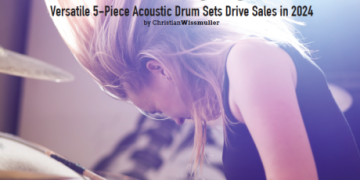 The fall semester is just around the corner. While you’re planning for “Back to School” sales and promotions, you’ll want to be sure to have plenty of one of the most popular B&O instruments, the flute, in stock. Student model flutes are designed to be approachable and easy to play for beginning musicians, durable enough to withstand the rough-and-tumble lifestyles of youngsters, and affordable enough to appeal to parents – particularly in today’s economic climate defined by record-setting inflation, across the board.
The fall semester is just around the corner. While you’re planning for “Back to School” sales and promotions, you’ll want to be sure to have plenty of one of the most popular B&O instruments, the flute, in stock. Student model flutes are designed to be approachable and easy to play for beginning musicians, durable enough to withstand the rough-and-tumble lifestyles of youngsters, and affordable enough to appeal to parents – particularly in today’s economic climate defined by record-setting inflation, across the board.
MMR recently connected with representatives from five of the biggest suppliers of student flutes to learn what features are being sought after by customers, what specific models are selling well in 2024, and how successful MI retailers go about marketing and displaying these instruments.
For your brand, what models of student flutes are the top-sellers?
Antonio Ferranti: For Proel North America, the top-selling student flute is our Ida Maria Grassi GR SFL290 Flute in C (School Series), alpaca silver-plated. Designed to be durable, reliable, and approachable for beginners, the Grassi SFL290 school flute promotes excellent intonation and is easy-to-play across all registers. The included E-mechanism facilitates easier performance, while the G-offset is ideal for musicians with smaller hands. The Grassi SFL290 flute comes with all necessary accessories for beginners, including a protective carrying case, cleaning cloth and rod. Additionally, all Ida Maria Grassi instruments are backed by an industry-leading 4-year warranty, ensuring long-term reliability and peace of mind for new musicians (or their parents).
Michael Summers: Our Jupiter 700 series flutes are best sellers. The JFL700 has hidden adjustment screws, while the JFL710 has top adjusting screws.
Brian Petterson: Yamaha offers a strong lineup of student flutes, highlighted by the extremely reliable and well-crafted YFL-222 and open hole variations. Our continuous efforts in research and development ensure we’ll remain current with market trends, and our designs have evolved over many years accordingly. Generations of Yamaha student models have been market leaders.
Korinne Smith: The Haynes Amadeus line of instruments is specifically designed for the beginner and intermediate student. Our best-selling models are the AF480 and AF680. The AF480 is geared for the beginner student. It comes with a silver-plated headjoint and sterling silver riser (a unique feature of this flute!), body and keys, plateau (closed hole) keys, French pointed arms, and a C footjoint. The AF680 was designed for the advancing student looking to “step-up” in their playing. In comparison to the AF480, the AF680 has a sterling silver headjoint, silver-plated body and keys, open-hole keys, French pointed arms, and a B footjoint.
Shawn Lafrenz: Our Belsona brand PF200 and P202 have been our most popular student line over the last two years since they were introduced.
The notion of a “student level” instrument is fairly subjective. In your mind, what constitutes a student flute?
MS: Student flutes are usually manufactured on a production line to help keep costs affordable, placing high importance on durability and ease of playability. Student flutes most often have nickel silver keys and hinge tubes, and a drawn nickel silver tube with drawn tone holes. Student flutes generally don’t have precious metals which would drive the cost up.
KS: Yes, you’re right, this question is very subjective. I think this is mostly because the term “student” doesn’t always denote a young player. One beautiful aspect of music-making is that we can pick it up at any time in our lives. A flutist can truly be a “student” at any age or skill level. Personally, my hope is that I will always be a student and that I will continue to hone my craft until I am no longer able to. But to answer your question, and it is a common one, would be that a “student flute” is determined by its playability and price point. A student flute is a flute that is approachable in terms of playability for the student and price for the parent/guardian, and one that, as the student grows and advances in their studies, could move up to the next level of instrument. The price point for student flutes ranges from $500-$2,000, intermediate flutes from $2,000-$4,000, pre-professional flutes from $4,000-$10,500 and professional flutes from $11,000 and up.
BP: A “student level” flute allows a new musician to experience making music positively. Hopefully, this leads the player to develop a deeper relationship with their instrument over time and into a lifetime of music making. The specifications of their first flute could vary based on the individual’s circumstances – physical, economic, and others – and the expert dealer salesperson’s ability to qualify the student, be familiar with the local educators, and guide the beginning of this musical journey is critical.
SL: There are a couple of factors that we pay special attention to: First, very durable instrument design in terms of keywork and action as well as a very easy blowing head joint cut that students can be successful with in their early playing. Second, as most of these instruments are sold through dealer rental pools, we make sure that our case and accessory options are appropriate for that kind of environment including a stackable ABS case.
AF: Ida Maria Grassi instrument designers believe a “student-level” flute should not be regarded as an instrument of lesser quality, but rather an instrument designed specifically with the performance and budget limitations of beginners in mind. This typically means that “student-level” instruments need to be easier to approach and play than “step-up” or more professional models, while also being more durable, and more affordably priced. To achieve this, Grassi engineers select materials that are more fortified to withstand frequent handling by younger or less experienced players. Things to look for in a student level flute include a simplified key mechanism for ease of playing, reliable intonation, and a head-joint that helps produce a sound more easily for those who are still developing their embouchure.
Aside from price-point, what features are customers looking for when considering the purchase of a student flute?
SL: Durability in product design and service after the sale from a reputable and dependable manufacturer are always important factors in the student market.
BP: The traditional closed-hole, entry-level model YFL-222 is the starting point for most students, which is why Yamaha designed the flute to be durable yet responsive and with a pleasant tone quality. However, many educators are encouraging students to begin learning on an instrument with more advanced specifications, like a sterling silver headjoint, a B foot joint and open hole keys (with plugs). The YFL-362H has become a very popular option for these educators.
AF: When selecting a student flute, several key factors are very important to ensure beginners have a successful experience. Durability is essential. Instruments must withstand the rigors of regular use and occasional mishandling. Ease of play is another important aspect, with flutes designed to allow beginners to produce sound easily and facilitate learning the fundamentals. Good intonation is critical, as instruments need to stay in tune to support proper musical development. Comfort and ergonomics are also important, with flutes that are comfortable to hold and play, featuring designs that can accommodate smaller hands. Lastly, care maintenance should be easy and straightforward, and include features that resist tarnishing and corrosion, to ensure consistent ease of play and instrument longevity. When beginners select an Ida Maria Grassi school series instrument, they are selecting all these features, designed by an expert Italian team of instrument specialists.
KS: When purchasing a student flute, customers are considering three main features: materials, mechanism, and headjoint. For materials, student flutes can be made of various amounts of silver-plated and sterling silver material. For example, the Haynes beginner student flute (AF480), like most beginner flutes, is made of nickel-silver alloy and is silver plated. However, the AF480 comes with a sterling silver riser instead of a nickel-silver material, which is a significant upgrade from that of its competitors. The more silver content in the instrument the more color, depth, and vibrance in the sound. As you ascend from there in the line, each model will incorporate more silver content. For example, the AF580 has a sterling silver riser and lip plate, the AF680 a sterling silver headjoint, the AF780 a sterling silver headjoint and body, and so on. For mechanism, options of closed holed (plateau keys) or open holes, Y-arms or French pointed arms, C footjoint or B footjoint, split E mechanism or G disc, C# trill or without are all options when purchasing a student flute. Lastly, when choosing a flute, finding the right headjoint style is imperative. Most of the instrument’s sound comes from the headjoint and therefore it is important to find a headjoint that feels comfortable, produces the sound the customer is looking for, and ultimately enhances their playing experience.
MS: Customers often look for a student instrument with a good warranty and are educator approved. Features commonly sought after are offset G, closed holes, low C foot, and silver-plated throughout. Jupiter student flutes incorporate the most accurate scale, modeled after our professional Altus flutes. We’ve also spent a lot of time refining the embouchure hole on our student flutes, which is a very important feature when choosing any flute.
What promotional and display approaches have you observed to be especially successful for MI retailers when it comes to these types of wind instruments?
KS: From the start of their musical career, flutists are made aware that their instrument is made of precious metals and materials that are extremely fragile. As a result, these instruments are thought of much like fine jewelry and should be displayed as such. Making sure the flutes, whether they are solid silver or silver-plated, are continually wiped down to retain their luster is extremely important to the overall aesthetic. I have seen beautiful displays where the flutes are either on pegs and/or laying down on a plush material inside a glass case. This is a great way to display the flutes, however, it is important to wipe them down and put them away in their cases at the end of each day. If left out for a long period of time, the silver can begin to tarnish and what were new instruments begin to look old and used. This will ultimately affect their sell through of these instruments. No matter how you decide to display flutes, the most important aspect is the care and maintenance of them.
MS: We offer posters and banners that dealers can display in stores, and that educators can display in classrooms. We also offer a series of educational videos to assist educators and new players with their instruments.
SL: Robust rental and repair service programs at the dealer level are incredibly important, but most successful MI retailers to also respond to local needs and special requests for accessory packages at the individual teacher level as much as possible.
AF: At Proel North America, we try to partner with our retailers to help create visually appealing store displays that highlight the key features and benefits of Ida Maria Grassi wind instruments, along with complimentary full-color brochures, to help our dealers’ retail staff and their customers. We also offer to support educational workshops and events, where students, parents, and educators can learn about our instruments, as well as their proper care and maintenance. Additionally, we have partnered with internationally renowned fellow manufacturers to offer cooperative bundling packages that include essential wind instrument accessories to help make starter packages even more appealing. Additionally, we provide rich product metadata, along with clear and detailed instrument imagery and videos to support the increasingly important role of online rentals and sales.
BP: We have seen Yamaha dealers have success in the student flute market through efforts to develop meaningful connections with local educators. Establishing themselves as local partners for educators and expert guides for customers maintains and grows the business yearly. Accordingly, promotions supporting long-term growth and enjoyment are essential, so Yamaha now offers an exclusive partnership with the revolutionary Tomplay interactive sheet music service. Any student who purchases or rents a Yamaha student flute is eligible for an extended free trial with Tomplay.
Do you feel the current popularity of flutes among younger players is fairly consistent, on the upswing, or experiencing a lull?
AF: Although Ida Maria Grassi wind instruments (founded in Italy in 1945) is now 79 years old, this is only its first year being imported to the USA and Canada, by Proel North America. Proel, and Italian company, has decades of experience and sales data with the European wind instrument marketplace, and the popularity of flutes among younger players has remained consistently strong and increasing internationally. Here in North America, the flute is always a perennial favorite in school band programs and is among the most played instruments due to its beautiful, melodious tone, approachable learning curve, and relatively lightweight and manageable size, particularly for younger beginners.
BP: The flute is one of the oldest wind instruments and will always have that fundamental appeal. The flute has also enjoyed a star turn over the past few years, with some global pop artists featuring the instrument. In the modern school music environment, recruiting new music makers to begin band is key, and that also means highlighting some of the many fun sides of playing flute: playing soaring melodies and creating new friendships with bandmates. Although the instrument can be challenging, the payoff is meaningful. There’s nothing better than seeing a student’s eyes light up when they start getting a consistent sound out!
SL: The percentage of flute players starting out is fairly consistent when compared with the total number of kids starting in band and orchestra programs. Learning to play the flute is always a popular choice for beginners.
MS: The popularity of all musical instruments is increasing, including the flute.
KS: The flute has always been a popular instrument since the beginning of time. The first instruments were in fact the drum and the flute! However, with the influence of Lizzo, Andre 3000, and other prominent artists of this century including the flute in various musical styles today, the instrument has grown in popularity. During COVID, we saw a significant increase in flute sales industry-wide. It was to the point where manufacturers couldn’t keep up with the demand and there was a significant shortage of student flutes. Dealers had to plan well in advance to make sure they had what they needed for rental and step-up sales season. I am pleased to report that manufacturers like the Wm. S. Haynes Company have since invested their resources to increasing production to meet the demand. While we are still experiencing that imbalance, the demand is encouraging us to continue to grow as a brand and we find that to be a good problem to have.
Expectations for this market segment in the coming months?
SL: We are looking forward to a robust fall beginner season!
BP: We expect the back-to-school season to be strong and that demand for Yamaha student flutes will grow, partly due to the new and creative ways we are working to drive customers to Yamaha dealers for purchases or rentals. As we do this, we know Yamaha dealers can be relied on to offer customers the highest levels of expertise, guidance, and customer service. Working collaboratively with our dealers with a customer-centric mindset will generate demand, grow our business together, and support the market’s long-term health.
KS: I am optimistic regarding the sales of student flutes over the coming months. We are extremely grateful to our partners and customers who have continued to believe in our products. As a result of their efforts and continuing our mission to create a Haynes for every player, the demand for our product continues to grow.
MS: We see it continuing to grow. As schools get prepared for a new season, we are approaching the busiest time of the year. Many dealers and educators like our flutes because of their consistency and low maintenance.
AF: Everyone at Proel North America is looking forward to our first back-to-school band season in the USA and Canada with Ida Maria Grassi wind instruments. After offering a first-look at our wind instruments at the NAMM Show in January, we then attended our first NASMD conference this year, and we are establishing wonderful relationships with the industry’s top school music and wind instrument dealers. We anticipate an exciting first back-to-school rental season, followed by a strong holiday gift season.
As for a general outlook towards the North American school market segment, our dealers are reporting the student instrument market is maintaining very strong demand, with potential for growth supported by increasing school music participation, growing interest in interactive music education platforms, and extracurricular band music opportunities as schools and communities continue to rebound stronger following the pandemic’s impact.
Additionally, the trend towards online rentals and purchases, as well as increasing interactive digital resources for education, are also fueling higher conversions of instrument rentals and ownership. At Proel, in addition to manufacturing high-quality Ida Maria Grassi wind instruments, we have the added benefit (and market insight) of also manufacturing wind instrument accessories, stage gear, and recording equipment which helps students enhance their experience, and retailers enhance their product offerings.


























